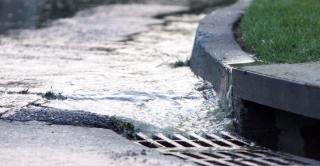Stormwater

Stormwater runoff is rainfall and snow melt that drains off impervious surfaces such as streets, parking lots, driveways, roof tops and compacted soils. It eventually drains into a storm drain in the street that discharges directly into local waterways such as rivers, streams, creeks and lakes. The concern with stormwater, is how it is managed locally for water quality and quantity or flood control. Storm drains play an important role in our city. It is unlawful for any person to dispose of debris, including grass clippings, on any street or sidewalk that can be washed into the stormwater drainage. Stormwater can carry many pollutants that have negative impacts on water quality such as;
- Sediment: Too much sediment (dirt that ends up in water) is not good for our environment. Sources of sediment include dirt on impervious surfaces that are washed away with rain, as well as eroded soil from unprotected construction sites and stream banks. Muddy water in streams and lakes that is full of sediment impacts fish and other aquatic life as well as changes the water chemistry.
- Fertilizers: Too much nitrogen and phosphorus in water is not good for the environment. Sources of nitrogen and phosphorus come from fertilized urban lawns and landscapes. Excess phosphorus in streams and lakes promotes algae growth, that depletes oxygen in the water. When this happens it not only makes for an unpleasant environment in which to swim or kayak, but fish and other aquatic life are impacted as well.
- Pesticides: A modest number of currently used and recently banned insecticides and herbicides have been detected in urban stream flow at concentrations that approach or exceed toxicity thresholds for aquatic life.
- Gas & Oil: Sources of hydrocarbons include oil and grease that leak from vehicles, gas station hot spots, parking lots and illegal dumping directly into storm drains.
- Trash (Litter & Debris): Considerable quantities of trash wash through the storm sewer systems and end up in our local streams, ruining the beauty of our natural environments.
What You Can Do at Home for Water Quality Improvements
You can be a part of local water quality improvements by implementing Rainscaping practices and proper yard waste disposal at your home to help with stormwater drainage. Several projects are eligible for reimbursement up to 50% with a maximum of $1000 annually, click here for a reimbursement application form. There are many Rainscaping Practices such as; rain barrels, soil quality restoration, rain garden, permeable pavement, native landscaping, and downspout redirecting. There are also many problems that can be addressed by Rainscaping solutions like patchy & brown grass, drainage & ponding issues, neighborhood drainage issues, local water quality, and community flooding. For more information on Rain Scaping and how to improve stormwater runoff click on the link below.
https://raincampaign.org/rainscaping-practices/
| Attachment | Size |
|---|---|
| 242.09 KB |

